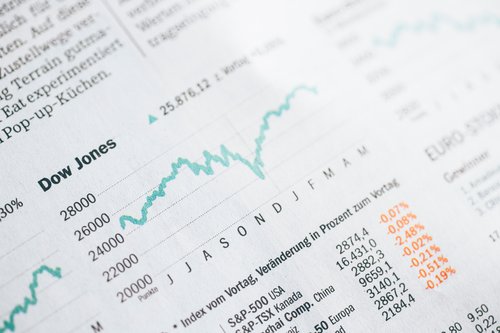Collision Of The Immutable K?
Tuesday, 15 October 2019By Jon Beckett
In the New Fund Order two Kaiju stand opposed each other. One on side Godzilla, the monstrous embodiment of Technology. On the other, GAIA, the colossus guardian of nature, and sustainability. Both tower over our society. As K waves, these long term secular trends can both transform society, the economy and even the planet. What if these K waves collide? Is technology compatible with sustainability?

In Wave Theory, according to Wiki, interference is a phenomenon in which two waves superpose to form a resultant wave of greater, lower, or the same amplitude. Constructive and destructive interference result from the interaction of waves that are correlated or coherent with each other, either because they come from the same source or because they have the same or nearly the same frequency.
Take the rise of Technology - the transformation of the S&P500 index leadership is remarkable. The index by constituent, today, is unrecognisable to even 10 years ago. Banks no longer drive the index, neither do autos. Likewise cap and multiple expansion is hugely concentrated in FANNGs ( Facebook, Apple, Amazon, Netflix Alphabet and Google) and S&P have struggled to manage. Those who think they are buying a broad basket of sectors underestimate the tech factor concentration. The sector changes last September by S&P appeared to have intensified, rather than diluted, this change. Is Moore’s momentum immutable, is it correlated to tech stocks? Is it a bubble? The feedback effect is huge as I wrote previously;
Compare this to rising investor demand in sustainable and funds focussed on Environmental Social Governance (ESG). This has become acute through Greta Thunberg’s controversial speech during her visit to the United Nations Climate Summit in New York.
Sustainability: The Rise of GAIA
As Reuters reported “The ranks of investors who say they pay attention to factors other than pure profitability are growing rapidly. Managers of stocks, bonds and other assets worth some $83 trillion have signed up to the Principles for Responsible Investment, an initiative backed by the United Nations that promotes the inclusion of environmental, social and governance factors in asset allocation.”

Meanwhile the growth in sustainable and ESG funds is pronounced. Morningstar recently reported that;
- There are over 2000 ESG focussed funds across Europe
- 36 Billion Euros have flowed into these funds so far in 2019
- Assets in these funds are estimated at nearly 600bn Euros
- There is a rapid rise of new launches and repurposed funds
It went on to state that;
“As of the end of June 2019, the team identified 2,232 sustainable funds domiciled in Europe. The European sustainable funds universe is defined as those open-end funds and exchange-traded funds domiciled in Europe that, by prospectus, either state that they use ESG criteria as a key part of their security-selection process or indicate that they pursue a sustainability-related theme or seek measurable positive impact alongside financial return............ It’s notable that sustainable equity funds have experienced inflows while conventional equity funds had net outflows over the past year........ These numbers confirm the growing popularity of dedicated strategies that incorporate environmental, social, and governance considerations.
Sustainable investing is fast becoming a mainstream pursuit. Supported by strong flows as well as positive stock market returns, sustainable European fund assets also reached a record level of EUR 595 billion......... as many as 168 new sustainable funds came to market in the first half of 2019. The industry is on track to match or even exceed 2018’s record of 305 new offerings.
While most of the growth in European ESG funds has come from new launches, asset managers have also repurposed and renamed existing funds.”
How does this demand relate to the rapidly growing Exchange Traded Funds market? According to ETF.com “For the year to 26 September, ETFs have attracted nearly $197 billion so far in new assets, roughly the same amount as last year, which registered a record year for new ETF assets. Also for the year, U.S. fixed income ETFs have widened their lead over U.S. equity ETFs for inflows, $97 billion to $82 billion, respectively.”
The reality is that ESG focussed ETFs remain dwarfed by flows into non ESG index products. IShares Core S&P500 ETF took over $7bn year to date while Vanguard’s equivalent S&P500 ETF took over $12bn. Compare this to flows into ESG ETFs. Marketwatch reported;
“The 2016 through 2018 period brought exponential growth in terms of sheer population for the U.S. ESG ETF universe. During that period, 52 ESG ETFs launched in the U.S., according to Morningstar. Rookie ESG ETFs are like any other new ETF: some find immediate success gaining investors' assets while others take time to gain favor among ETF users."
“With these newer ETF options starting to attract flows in 2018, ETFs accounted for about 40% of overall net flows to sustainable funds,” said Morningstar. “In the previous two years, ETFs had accounted for only about 20% of overall net flows to sustainable funds. Still, 2018 flows to ESG ETFs were dominated by iShares, the world's largest ETF issuer.”
Whether this exposes a dichotomy between index investors and ESG preferences or a growing divide between European and US investor behaviour is difficult to discern. Where might interference arise between ESG and ETFs? First consider that investors are inclined to invest in companies that exhibit better standards of ESG but moreover seek the momentum from Big Tech. Then reflect how the S&P500, the most popular ETF index, has itself changed. We can observe that Finance has lost its control of Big Tech; which now capitalises the very largest of the world’s global markets. The global economy is caught in its momentum.
Big tech is one massive K-wave that permeates investor portfolios and our day to day lives from; the way markets are traded, the tech we use, the jobs we no longer do, the goods we buy, to even how we interact with one another. Humans like the accessibility of Tech, the performance of tech stocks in their portfolios and the convenience they bring to daily lives. Investors do not necessarily like the effects of Tech to society and to jobs. All of which can be subject to populism and politics.
In the ashes of the Great Financial Crisis, the loss of confidence merely accelerated the demise of the high street as people stayed in their homes, Tech was ready to disrupt the household. Thus technology was no longer benign for its financial masters. Godzilla was unleashed!
If we focus on the S&P500, the world’s most traded index, then in that time the S&P has changed considerably and this is worth reflecting on. The S&P 500 opened January 1957, at 386 points. It rose to nearly 700 over its first decade, the boom that followed the end of World War II. Yet it took more than 20 years for those highs to again be decisively broken.
From 1969 to early 1981, the index declined, falling under 300 points. This period was noted for stagnant growth and high inflation while the S&P 500 declined more than 50%. Eventually, through high interest rates, the Federal Reserve successful reduced inflationary pressures. This and the rapid investment and floatation in Tech stocks through the late 90s. From 1982-2000 the S&P 500 climbed 1,350%. We can also observe the rise of emerging markets and commodity cycles through this period. A period of globalisation and new markets.
2000 of course marked the top of stock market bubble. It was one based on fanciful overvaluations, excess public enthusiasm for young Internet stocks, excess liquidity and speculation in the technology sector culminating in fairly loose CapEx. This bubble of course burst. While the technology-heavy NASDAQ free-fell nearly 90%, the S&P 500 fell 40%, bottoming into 2003. Its exposure to Tech at the time was relatively contained, with the likes of established Microsoft, IBM and Oracle as noted exceptions. Yet it was still banks and industrials that led the weight of the S&P returns.
The S&P500 once again managed to recover to new highs in 2007, fuelled by low interest rates, housing, financial stocks, and commodity stocks. However, these index gains were again reversed during the GFC when the S&P 500 fell 57% until bottoming out in March 2009. Over the last decade, it has climbed again by more than 400% to new all-time highs. The key difference this time is that Big Tech have become the leaders for the S&P500, the ‘FANNGs’, many of which were survivors from the dot.com bubble 10 years previous.
After strong performance through 2017, the S&P 500 peaked in February 2018 at 2,836. By December 24, 2018, the S&P 500 fell hard, somewhere between correction territory and bear market, before again starting to recover.
Godzilla Advances

What we now have to observe is that the performance of Big Tech has become absolutely central to the recent and ongoing performance of the S&P500. Partly why is the way the S&P is constructed, as a market-cap-weighted free float and also its relationship with Exchange Traded Funds. Ironically it has been Corporate Treasury actions like Buy Backs that have been dominating the order book this year, hedge funds now account for less AUM than ETFs which have been see-sawing flows for 12 months. Active managers find themselves the minority as large volumes are traded to cover derivative contracts.
Try to put this into some sort of context. The first S&P500 ETF launched by State Street over 20 years ago then later popularised in recent years by Vanguard and Blackrock. Recall, originally, the S&P500 was designed to simply inform investors, a means to report how markets were doing through newspapers in a time lagged fashion, an index, a benchmark. Certainly compared to the Dow the S&P was a more efficient means of reporting how Capital was being allocated but not necessarily intended to drive the future allocation of capital. Then index products rose. In my opinion (and others) this reverse use of indices coupled with a historically low discount rate has created something of a Minsky moment post-GFC: the leverage and commoditisation of listed equities. Encouraged by index-sponsored studies like the S&P SPIVA report, vast feedback loops have emerged through media, traditional active managers are no longer the dominant share of the daily order book. This could prove immutable and poses a complete rethink how investors may want to invest in equities. Does aggregation and supply-demand, via the market cap mechanism, now outweigh valuation? It poses a secular question for the Efficient Market Hypothesis.
For the last 5 years unlimited open-ended ETFs have deployed vast capital through order-driven exchanges, unchallenged, forcing capital into fixed capital, closed ended stocks driving both multiple and shares in issue expansion. It poses whether a fundamental flaw in Efficient Market Hypothesis now arises and at the centre of all of this is BIG Tech and the outcome being rapid price-multiple expansion in FANNGs and the ETFs now concentrated in them.
Through index tracking, capital was now being deployed based on look-back market values, concentrating capital allocation towards the biggest balance sheets and mostly highly geared. Free-floating Market Cap indices reflect the price of tradeable shares in issue. Free-float indices have become perceived champions of the average investor. Indeed lower-cost investing and transparency have been long overdue in asset management. Yet free-float indices only serve as a methadone for the masses and ETF providers may do well to avoid them. Initially ETF replication was not a problem when the ratio of ETF investment to the markets was small. Today mass-replication and large inflows mean index ETFs is estimated by some to be as high as 60% of daily trading volumes.

What you then get is a disconnect between Price and Earnings, valuation becomes secondary, you instead get index revisions and multiple expansion, the market cap weighted indices then allocate based on the size of the capitalisation of its constituents, which are rising because they have more money allocated through order driven systems, which creates a large feedback loop. The price rises, weight in index increases, ETFs allocate more based on increased weight. The price rises because of increased allocation. Historically we can understand this phenomenon has been both exceptional and relatively short lived. The index has exhibited asset bubbles before. Yet without information or technology advantage the role of traditional investment management unravels and decomposes. Old schools of thought like value investing become optically trampled. The likelihood of all of this was utterly underestimated by the investment industry 10 years ago. More recently doubts as to the sustainability of this momentum have grown and the rise in ESG will again interfere with that momentum. Many active managers see the rise of ESG as a lifeline; as passive providers seek to persuade investors that ESG can be delivered through corporate engagement alone.
Standard & Poor’s is also aware of the rising risk in 'Big Tech' and has taken some limited action. Last August S&P announced steps to curtail the dominance of Tech in the S&P500, and these will change the dynamics of S&P500 sectors and the ETFs tracking them. It followed the S&P500 Committee’s inability to rebalance the multiple expansion of Big Tech, concentrating the market cap within the index. At 26% of the index, Tech is a larger component than weightings in the Russell 2000 (15 percent), the S&P Mid Cap (16 percent) or Small Cap (15 percent).
Tech's dominance of the stock market then is a big issue for every investor, and S&P's move a sign of the times. What can the S&P index committee do in the face of seemingly endless investor appetite for mega-cap tech names? The Telecomm sector was renamed the ‘communication services’. Last September, 23 companies moved from the S&P 500 Consumer Discretionary sector (16 stocks) and Tech sector (6 stocks) to the new sector. The new Communications Services sector had a 57% weighting in what is currently the Technology sector, 32% in Consumer Discretionary and 11% in Telecomm. It will be about 10% of the S&P 500 versus just 2 percent right now.
- Alphabet and Facebook are both moving to Comm Services from Technology. So are three smaller names: Activision, Electronic Arts and Take Two. Facebook's weighting in the new sector is 18.4%; Google/Alphabet is a combined 25.8%. Activision (4.5%) and Electronic Arts (4.2%) making up key positions.
- From Consumer Discretionary, the important names shifting to Comm Services are Disney and Comcast (both 5% weightings in the new sector). Netflix (3.9%), as are Twitter (2.2%) and CBS (1.9%).
However these changes might have the opposite effect. They might create even further tech concentration. Specifically it leaves Google and Facebook — with 44.2% of the new sector. Four companies (adding Comcast and Disney) represent 52% of the sector and the top 10 positions (nine companies) accounting for 77% of the new sector. As concentrated as the current S&P Technology sector was, the top two names (Apple and Microsoft) were only 26.6% of the group. The top 10 positions were 61%. Even the Consumer Discretionary sector, dominated by Amazon (23.7% weight), had less exposure to its top 10 names (62.8%) than the new Communication Services group.
Given the market correction in Q4, these changes could have important implications for ETFs tracking these sectors. Stock specific risk also rises, perhaps moving focus back to valuations and earnings.
Interference?

Going into 2018 the price momentum for FANNGS continued to look strong relative to the rest of the S&P500. However price charts also implied a pronounced stretch in price multiples between FANNGs and the rest of the index. Then into 2018 what we saw was actually a lot more volatility. Some coincided with the Facebook and Cambridge Analytica scandal and some from growing US-China tensions but that can’t explain all of the volatility we saw. No, what has likely been rising is a growing structural concern of the valuation levels and concentration of Big Tech. Among the FANNGS, Netflix in particular has been the strongest performer, recently, as Amazon and Facebook saw declines going into Q4 2018. Alphabet meanwhile had shown STOIC growth with a more mature return, some volatility but compared to other FANNGs, its performance has looked more like that of a Utility than a Tech stock. 2019 has shown some recovery but we remain off 2018 highs, the sensitivity of BIG tech to index ETF flows and visa versa remains high.
Other than valuation, what undermines Big Tech is a persistently poor reputation for ESG. Whether a bias exists fed by active management is a difficult question to answer. However there remains enough independent agencies to draw from. What are the issues?
Amazon is a case in point - “if investors look through the lens of environmental, social and governance (ESG) management, there are serious issues for the firm. Amazon has been plagued by class-action lawsuits on wages and working conditions, and strikes by Amazon workers in Germany, Italy, Poland and Spain. By routinely paying wages barely above the U.S. poverty line for a family of four, using intrusive surveillance systems to monitor its employees - such as timed bathroom breaks - and imposing constant pressure to hit targets, Amazon is clearly a laggard rather than a leader in labour practices.”
The Carbon Disclosure Project also has Amazon in their sights - “CDP’s target list features big names such as Amazon, ExxonMobil and Chevron alongside about 700 other companies chosen for their high environmental impact and low transparency. Some investors have warned that they may sell their holdings of companies which do not comply. Earlier this year, nearly 8,000 Amazon employees signed an open letter to chief executive Jeff Bezos demanding the company publicly report how it is preparing for climate-related disruptions. The issue came to a vote in May as a shareholder resolution, but was defeated even after winning support from the industry’s two most influential proxy advisers, ISS and Glass Lewis.Amazon’s board argued in its proxy statement that the resolution was unnecessary, saying it already reports enough on climate issues. “We are on a path to becoming the most sustainable retailer and cloud provider in the world, and will release our carbon footprint later this year,” the company said.”
One Faang member that is no stranger to criticism is Apple. The tech behemoth has been accused of everything from avoiding paying tax to the abuse of workers around the world. Infamously, 14 workers assembling iPhones at the Foxconn-run plant in Longhua, China, committed suicide because of poor working conditions, stress and long workdays in 2010.
Differences of opinion on Apple are not hard to find. Hermes Investment Management and Wheb Group take opposing stances on the company. Lewis Grant, senior portfolio manager of the Hermes Global Equity ESG fund, has invested in Apple and praised the firm for bouncing back from several controversies. On the flipside, for Wheb, Apple fails to meet the company’s thematic ESG criteria. Seb Beloe, head of research at Wheb, points out that Apple’s ultimate purpose does not justify investment for its sustainable mandates.”
Facebook is also under fire - Edentree Investment Management and Liontrust Asset Management have both dropped Facebook from their sustainable funds. Edentree Higher Income manager Tom Fitzgerald said while Facebook has taken steps to improve, the direction of travel is not yet significant enough. "Our ESG team and investment team appreciate that Facebook has done a lot for society, it’s improved connectivity, it’s brought free communication to areas of the world that would not have it, but we think there are huge issues around its impact on society, such as bullying. It’s been shown to have a negative impact on younger user demographics. The whole data privacy issue, we have concerns about and we think the company still doesn’t have full grasp of who’s using its data and how they’re using it."
Mike Appleby, investment manager on the Liontrust Sustainable Investment team, says despite rating Facebook eligible for investment in early 2017, they have since reassessed that view. Following a meeting with Facebook in H2 2017, Liontrust’s sustainability team concluded while Facebook was taking steps to address many identified issues, its response was inadequate in light of the risk to its profitability.
These views are repeated across the active management industry and suggests a key issue for Big Tech continuing its momentum. However it will need the ETF market to follow the trend towards ESG and specifically divestment from the S&P500 to catalyse. It also asks a much more searching question of consumers and investors.
Collision: Convenience versus Conscience?
Just as people became more familiar with technology in their own daily lives then they are becoming more attune to Technology managing their futures and appearing in their portfolios. Big Tech is becoming the new go-to Utility, buoyed by accelerating networks and decline of traditional industry, Media, Retail and Finance. This has created a huge feedback and validation of Technology as both a source of rebalancing the economy and social advancement. Facebook today has over 2 billion users from a total world population of 7.6 billion. For now Amazon benefits from its price-multiple expansion. Few could have anticipated Amazon’s future success and so investors are split broadly into 4 types;
1) Regretters who wished they have invested and desperately seeking the next Amazon
2) Late Charlies who invest on continued momentum and multiple expansion
3) Profit takers who are looking to offload in order to crystallise previous gains
4) ETF and Index holders computed on Amazon’s weight in the S&P500

What gives momentum to investors hope is that the Technology K-wave continues to accelerate. The immutable growth of computing power known as Moore’s Law, at least doubling of computing power at least every 2 years, exploiting and disrupting the inefficiency of human intensive industries. Meanwhile ESG focussed investors will continue to rotate away until Big Tech companies begin to report better ESG ratings. How do we reconcile?
- Technology firms, which have driven momentum in most major market cap indices, often score poorly from ESG agencies. Despite rhetoric of index providers this simple fact is unavoidable.
- Meanwhile Sustainability and Environmental Social Governance (ESG) have increasingly dominated the headlines but not how they relate to Technology companies and investment into Tech dominated indices?
- Lastly the rise of social networks on face value could empower people towards driving more sustainable decisions or not. The partisan reactions to Greta Thunberg is telling. Social networks and online vendors also increase consumption, which itself can be unsustainable.
As noted by Citywire “There is little moral ambiguity around traditional sin stocks, such as arms and tobacco companies, but the Faangs (Facebook, Apple, Amazon, Netflix and Google) fall into a disputed grey zone. Dominant as they may currently be, asset management companies are subjecting them to tough, thematic criteria, and getting different results. Avoiding the FANNGs might seem high risk, given the returns they have generated over several years, even with the recent sell-off. But the growing prevalence of environmental, social and governance (ESG) criteria, coupled with young buyers’ fondness of ethically-minded investments, is changing where people allocate their money.”
Which leave two potential outcomes
Destructive Interference- As the K waves collide, FANNG multiple expansion may de-correlate with Moore’s Law at some point, as available disruptable markets shrink and ESG concerns rise.
Constructive Interference - Alternatively we may see ESG catalyse a rapid shift of technology towards sustainability and Big Tech may become the most powerful ESG companies. .